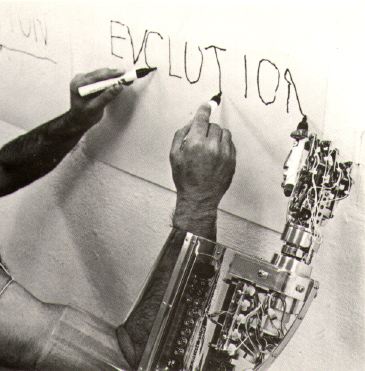Home
Syllabus
E-mail Class
E-mail Craig
Resources
Journal
Discussion
Assignments
Schedule |
Analytical Essay I (Project 4)
A Close Reading and a "Far Reading"
Write an five-to-seven-page essay in which you do a detailed analysis
of one Web site, which answers one of the three questions
that appear below. These three questions/options are ongoing concerns
in readings from the Trend collection on digital culture. In dealing with
the question, you should:
a. answer the question by doing a "close reading"
of the site, describing and discussing the specific choices of design,
writing and content made by the site's creators (in aesthetic or usability
terms, e.g., Nielsen),
b. then, step back to answer the question further by citing,
quoting and discussing at least two articles from the Trend collection
that provide critical languages and a "lenses" through which
to describe the site's social/cultural/political implications. By stepping
back, you'll do a "far reading," looking at the site's social
context, consequences and/or significance not just in themselves, but
as an example of the phenomenon of the Web and digital culture. As much
as possible, support the critique with the specific examples of content-
and site-design you detailed in your close reading.
Options
Option/Question 1: the body vs. virtuality
- Where and how does this site refer to (or invoke a sense of) the body,
bodily existence, bodily identity (age, gender, race, class, physical
or economic "place" in the world), a connection to nature,
the concerns of bodily or economic beings and the material commodities
they need?
- How does the site realize the hopes and/or critiques of one or two
writers in the Trend collection concerning issues of the body and virtuality?
(Some relevant critics concerning the body and virtuality include Morse,
Heim, Jackson, Levy, Turkle, etc.)
- For instance, does this site represent an enhanced integration or
coordination of the bodily and virtual selves--to "enrich the real"
(Turkle 249)--or does it represent a "rupture of our previous relationship
to time and space" and a displacement of "life" (Jackson
349)?
Option/Question 2: traditional vs. virtual community/identity
- Where and how does this site invoke and "normalize" a particular
sense of community, social identity(ies), affiliation, belonging, social
interaction (actual, virtual, simulated or implied), "public space"
(Poster 263), democracy, subcultures, traditional roles and authorities,
etc.?
- How does it realize the hopes and/or critiques of one or two writers
in the Trend collection concerning community and identity? (Some suggested
writers: Turkle, Rheingold, Heim, Levy.)
- For instance, in what ways does this site either reinforce or subvert
traditional identities, social authority and power relationships? Who
is included and excluded ("normalized" into or out of the
picture)?
Option/Question 3: information vs. experience
- Where and how does this site present its content not just as static,
neutral "information" (lists, paragraphs), but as an experience,
a "knowledge space" (Levy 255), a metaphorical space or world,
an imaginative "performance" (Laurel), or as a value-added
gateway to the "metatext" or "docuverse" of the
Web?
- How does it realize the hopes and/or critiques of one or two writers
in the Trend collection concerning the Web as a knowledge space? (Some
suggested texts: Laural, Jackson, Heim.)
- For example, in what ways does this site represent a "New Aesthetic"
(Jackson) or a disintegration of aesthetic and intellectual values?
Format:
- Begin your essay by introducing your topic and stating a "thesis"--that
is, one conclusion that synthesizes your thinking about the significance
of the Web site as an example of the phenomenon of the Web, Web design
and digital culture. You might want to include in your introductory
paragraph the name of a critic from the Trend book whom you will
depend on especially in the essay, and perhaps even a provocative
quotation to hook the reader. Do not mention the assignment or the
three options. (Suggestion: rewrite this introduction after you finish
the body of the essay.)
- Explore the question/option you've chosen without repeating
the question or making reference to the assignment. Make it sound as
if you thought up the issue yourself, and that it's a natural outgrowth
of your informed reaction to the Web site. Be sure to quote and cite
at least two writers from the Trend collection. It may be especially
valuable is to choose two writers whose ideas constitute a kind of debate
or disagreement about digital culture (and, so, about the Web site you're
analyzing), which you
- End the essay by briefly recalling the thesis or conclusion
you presented in the introduction and adding something extra
(a "kicker"), perhaps an example, detail, quotation or observation
that's interesting, funny, or thought provoking which you didn't include
in the essay so far, but which suggestions a further implication of
your analysis, or that illustrates or crystallizes your overall point.
Quotations, Citations and Documentation
Be very scrupulous about putting quotes around other writers' words and
crediting the quotations with in-text citations. Failing to do so, even
accidentally or ignorantly, is plagiarism, and is grounds for failure
of the paper and the class. If you paraphrase an author, be sure to use
your own words and sentence structures.
Cite the authors and page numbers parenthetically in the text--at the
end of the sentence where the quotation appears--and document the source
in a "Works Cited" page at the end of the essay using MLA
format.
|

